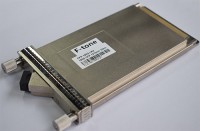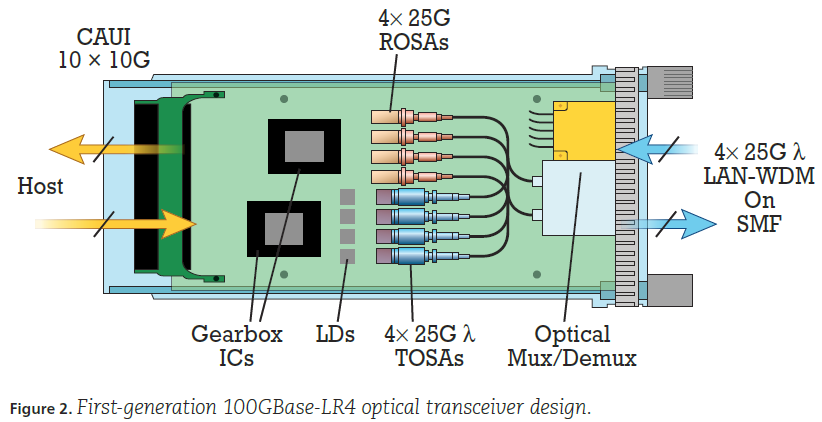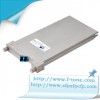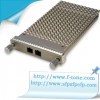标准光模块

CFP 100GBASE-LR4 module
Specifications
- 产品型号: CFP-100GBASE-LR4
- 兼容品牌: 全系列
- 封装类型: CFP
- 传输速率: 100G
- 传输距离: Up to 10km transmission
- 发射波长: CWDM
- 接收波长: CWDM
- 工作温度: 商业级0℃~+70℃/工业级-40℃~+85℃ 可选
- 数字诊断: 带DDM
- 接收灵敏度: Up to 10km transmission
- 接收灵敏度: Up to 10km transmission
Description
F-tone CFP 100GBASE-LR4 module
supports a link length of 10 kilometers on standard single-mode fiber (SMF, G.652). 100 Gigabit Ethernet signal is carried over four wavelengths. Multiplexing and demultiplexing of the four wavelengths are managed within the device.
- CFP MSA package with duplex LC connector(straight/angled)
- Integrated heat sink optional
- Supports multi-rate from 103.1Gb/s to 111.8Gb/s aggregate
- Lane bit rate 25.78 Gb/s GbE, 27.95 Gb/s OTU4
- Up to 10km transmission on SMF
- EML laser and PIN receiver
- High speed I/O electrical interface (CAUI)
- MDIO interface with integrated digital diagnostic monitoring
- Single +3.3V power supply
- Maximum power consumption 16 W
- Operating case temperature: -5°C to +70°C
- Compliant to RoHS Directive 2011/65/EU
Ordering information:
| Part No. | Data Rate | Fiber | Distance | Interface | Temp. | DDMI |
| CFP-161HG-10-L | 103Gbps | SMF | 10km | LC | Standard | Yes |
| CFP-161HG-10-LA | 112Gbps | SMF | 10km | LC | Standard | Yes |
CFP Wiki
The CFP Multi-Source Agreement (MSA) defines hot-pluggable optical transceiver form factors to enable 40Gb/s and 100Gb/s applications, including next-generation High Speed Ethernet (40GbE and 100GbE). Pluggable CFP, CFP2 and CFP4 transceivers will support the ultra-high bandwidth requirements of data communications and telecommunication networks that form the backbone of the internet.

CFP MSA Operating Rules Issue 1.3
CFP MSA 100G Roadmap and Applications
CFP 100GE-SR10 Applications
Next Gen PMD CFP MSA Baseline Specifications
High Speed TX & RX Pin Separation
OIF Multi-Link Gearbox (MLG) Project Start Proposal
100Gb/s & Beyond Ethernet Optics
The first-generation 100GBase-LR4/ER4 optical transceiver architecture is similar to that of the 40GBase-LR4, but with the speed of the active optoelectronic components increased to 28Gbps for realizing a 4x28G optical interface. Additionally, the CAUI electrical interface defined in IEEE 802.3ba-2010 is widened from 4x10G lanes to 10x10G lanes. A 10:4/4:10 “gearbox” serializer/deserializer IC is used to implement the electrical interface between the 10-lane host data path and the four-lane optical data path.
The optical interface defined in IEEE 802.3ba-2010 uses a four-wavelength LAN-WDM 800-GHz wavelength grid in the 1310-nm band and optical multiplexing/de-multiplexing on single mode fiber. The transmitter optical specifications for LR4 and ER4 are based on cooled electro-absorption modulation with integrated DFB (EA-DFB) laser technology, but were written to allow eventual implementation with directly modulated DFB lasers for smaller size, lower power consumption, and lower cost TOSAs.
The receiver optical specifications for LR4 and ER4 are based upon PIN-PD detector technology with integrated TIA. The receiver specification also includes optical amplification, such as from a semiconductor optical amplifier, to compensate for optical fiber attenuation loss in the ER4 40-km application.
These components are packaged into the CFP pluggable module (previously shown in figure 1) with non-coaxial, 28-Gbps electrical connections between the discrete component TOSAs, ROSAs, and gearbox IC, as shown in figure 2 below.

The first-generation 100Gbase-LR4 module power dissipation is typically in the range of 24 W, which poses significant thermal management challenges for system designers, particularly as they seed to increase 100GbE optical port density. Thus, there is strong motivation to significantly reduce the 100GBase-LR4 optical transceiver module power dissipation in the next-generation design.
by fiberopticsforsale (Colin Yao)
TX&Sensetivity LCFP LR4
OTU4 4I1-9D1F Operation
| Parameter | Symbol | Min. | Typical | Max. | Unit |
| Transmitter | |||||
| Signaling Speed per Lane | BRAVE | 27.95 | Gbps | ||
| Lane_0 Center Wavelength | λC0 | 1294.53 | 1295.56 | 1296.59 | nm |
| Lane_1 Center Wavelength | λC1 | 1299.02 | 1300.05 | 1301.09 | nm |
| Lane_2 Center Wavelength | λC2 | 1303.54 | 1304.58 | 1305.63 | nm |
| Lane_3 Center Wavelength | λC3 | 1308.09 | 1309.14 | 1310.19 | nm |
| Total Average Output Power*(Note4) | Po | - | 8.9 | dBm | |
| Average Launch Power per Lane | Peach | -2.5 | 2.9 | dBm | |
| Side Mode Suppression Ratio | SMSR | 30 | dB | ||
| Optical Return Loss Tolerance | 20 | dB | |||
| Extinction Ratio*(Note5) | ER | 7 | dB | ||
| Transmitter eye mask definition {X1,X2, X3, Y1, Y2, Y3}*(Note5) | G.959.1 Compliant | ||||
| TX Disable Assert Time | t_off | 100 | us | ||
| Receiver | |||||
| Signaling Speed per Lane | BRAVE | 27.95 | Gbps | ||
| Lane_0 Center Wavelength | λC0 | 1294.53 | 1295.56 | 1296.59 | nm |
| Lane_1 Center Wavelength | λC1 | 1299.02 | 1300.05 | 1301.09 | nm |
| Lane_2 Center Wavelength | λC2 | 1303.54 | 1304.58 | 1305.63 | nm |
| Lane_3 Center Wavelength | λC3 | 1308.09 | 1309.14 | 1310.19 | nm |
| Average Receive Power per Lane | Rpow | -8.8 | 2.9 | dBm | |
| Receive Sensitivity per Lane*(Note7) | Pmin | -10.3 | dBm | ||
| Receiver Overload | Pmax | 5.5 | dBm | ||
| Optical Return Loss | ORL | -26 | dB | ||
| LOS Assert | LOSA | -12.7 | dBm | ||
| LOS De-Assert | LOSD | -10.7 | dBm | ||
| LOS Hysteresis | 0.5 | dB | |||
100GBASE-LR4 Operation
| Parameter | Symbol | Min. | Typical | Max. | Unit |
| Transmitter | |||||
| Signaling Speed per Lane | BRAVE | 25.78 | Gbps | ||
| Lane_0 Center Wavelength | λC0 | 1294.53 | 1295.56 | 1296.59 | nm |
| Lane_1 Center Wavelength | λC1 | 1299.02 | 1300.05 | 1301.09 | nm |
| Lane_2 Center Wavelength | λC2 | 1303.54 | 1304.58 | 1305.63 | nm |
| Lane_3 Center Wavelength | λC3 | 1308.09 | 1309.14 | 1310.19 | nm |
| Total Average Output Power*(Note4) | Po | 10.5 | dBm | ||
| Average Launch Power per Lane | Peach | -4.3 | 4.5 | dBm | |
| Side Mode Suppression Ratio | SMSR | 30 | dB | ||
| Optical Return Loss Tolerance | 20 | dB | |||
| Extinction Ratio*(Note10) | ER | 4 | dB | ||
| Transmitter eye mask definition {X1,X2, X3, Y1, Y2, Y3}*(Note10) | IEEE 802.3ba-2010 Compliant | ||||
| TX Disable Assert Time | t_off | 100 | us | ||
| Receiver | |||||
| Signaling Speed per Lane | BRAVE | 25.78 | Gbps | ||
| Lane_0 Center Wavelength | λC0 | 1294.53 | 1295.56 | 1296.59 | nm |
| Lane_1 Center Wavelength | λC1 | 1299.02 | 1300.05 | 1301.09 | nm |
| Lane_2 Center Wavelength | λC2 | 1303.54 | 1304.58 | 1305.63 | nm |
| Lane_3 Center Wavelength | λC3 | 1308.09 | 1309.14 | 1310.19 | nm |
| Average Receive Power per Lane | Rpow | -10.6 | 4.5 | dBm | |
| Receive Sensitivity in OMA per Lane*(Note7) | Pmin | -8.6 | dBm | ||
| Receiver Overload | Pmax | 5.5 | dBm | ||
| Optical Return Loss | ORL | -26 | dB | ||
| LOS Assert | LOSA | -13.6 | dBm | ||
| LOS De-Assert | LOSD | -11.6 | dBm | ||
| LOS Hysteresis*(Note9) | 0.5 | dB | |||
For more details and most updated date please refer to pdf




